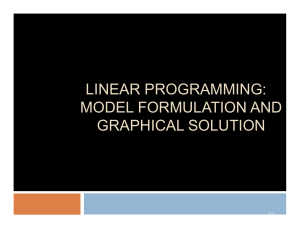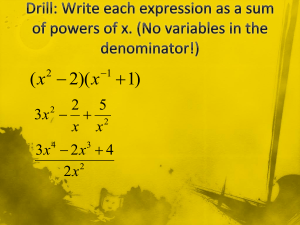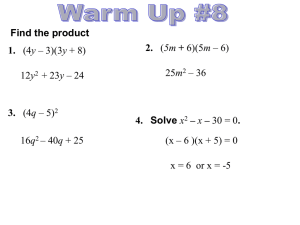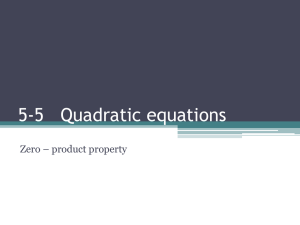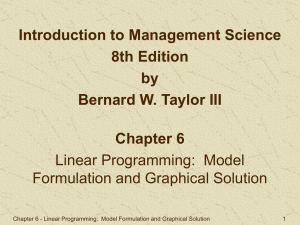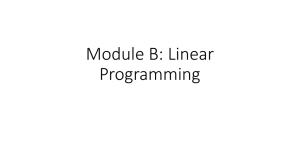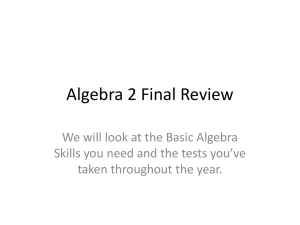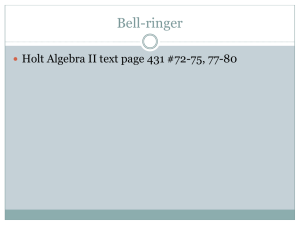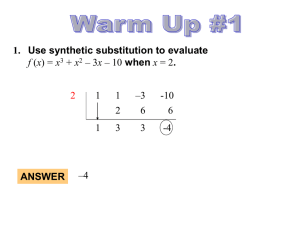x 1 , x 2 0
advertisement
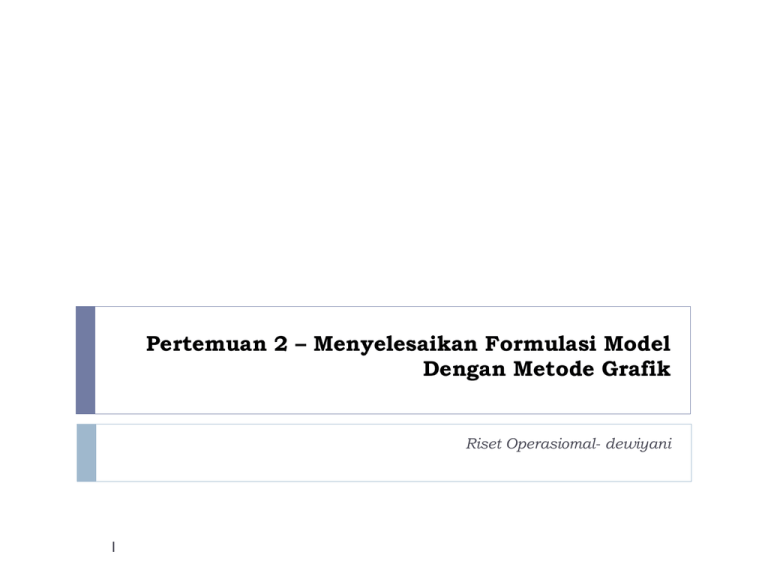
Pertemuan 2 – Menyelesaikan Formulasi Model Dengan Metode Grafik Riset Operasiomal- dewiyani 1 Methods to Solve LP Problems Graphical Method Simplex Method Problem Definition A Maximization Model Example (1 of 3) Product mix problem - Beaver Creek Pottery Company How many bowls and mugs should be produced to maximize profits given labor and materials constraints? Product resource requirements and unit profit: Product Resource Requirements Labor Clay Profit (hr/unit) (lb/unit) ($/unit) Bowl 1 4 40 Mug 2 3 50 3 4 Problem Definition A Maximization Model Example (2 of 3) Resource Availability: 40 hrs of labor per day 120 lbs of clay Decision Variables: x1 = number of bowls to produce per day x2 = number of mugs to produce per day Objective Function: Maximize Z = $40x1 + $50x2 Where Z = profit per day Resource Constraints: 1x1 + 2x2 40 hours of labor 4x1 + 3x2 120 pounds of clay Non-Negativity Constraints: x1 0; x2 0 5 Problem Definition A Maximization Model Example (3 of 3) Complete Linear Programming Model: Maximize Z = $40x1 + $50x2 subject to: 1x1 + 2x2 40 4x2 + 3x2 120 x1, x2 0 6 Feasible Solutions A feasible solution does not violate any of the constraints: Example x1 = 5 bowls x2 = 10 mugs Z = $40x1 + $50x2 = $700 Labor constraint check: 1(5) + 2(10) = 25 < 40 hours, within constraint Clay constraint check: 4(5) + 3(10) = 70 < 120 pounds, within constraint 7 Infeasible Solutions An infeasible solution violates at least one of the constraints: Example x1 = 10 bowls x2 = 20 mugs Z = $1400 Labor constraint check: 1(10) + 2(20) = 50 > 40 hours, violates constraint 8 Graphical Solution of Linear Programming Models Graphical solution is limited to linear programming models containing only two decision variables (can be used with three variables but only with great difficulty). Graphical methods provide visualization of how a solution for a linear programming problem is obtained. 9 Coordinate Axes Graphical Solution of Maximization Model (1 of 13) Maximize Z = subject to: $40x1 + $50x2 1x1 + 2x2 40 4x1 + 3x2 120 x1, x2 0 After defining the axes, begin drawing the constraints • What is the x or y intercept? • What is the slope? Figure 2.1 Coordinates for Graphical Analysis 10 Labor Constraint Graphical Solution of Maximization Model (2 of 13) Maximize Z = subject to: $40x1 + $50x2 1x1 + 2x2 40 4x1 + 3x2 120 x1, x2 0 Figure 2.1 Graph of Labor Constraint 11 Labor Constraint Area Graphical Solution of Maximization Model (3 of 13) Maximize Z = subject to: $40x1 + $50x2 1x1 + 2x2 40 4x1 + 3x2 120 x1, x2 0 After the labor constraint, let’s move onto the clay constraint • What is the x or y intercept? • What is the slope? Figure 2.3 Labor Constraint Area 12 Clay Constraint Area Graphical Solution of Maximization Model (4 of 13) Maximize Z = subject to: $40x1 + $50x2 1x1 + 2x2 40 4x1 + 3x2 120 x1, x2 0 Figure 2.4 Clay Constraint Area 13 Both Constraints Graphical Solution of Maximization Model (5 of 13) Maximize Z = subject to: $40x1 + $50x2 1x1 + 2x2 40 4x1 + 3x2 120 x1, x2 0 Figure 2.5 Graph of Both Model Constraints 14 Don’t forget the non-negative constraints Graphical Solution of Maximization Model (6 of 13) Maximize Z = subject to: $40x1 + $50x2 1x1 + 2x2 40 4x1 + 3x2 120 x1, x2 0 X2 = 0 X1 = 0 Figure 2.6 Feasible Solution Area 15 Feasible Solution Area Graphical Solution of Maximization Model (7 of 13) Maximize Z = subject to: $40x1 + $50x2 1x1 + 2x2 40 4x1 + 3x2 120 x1, x2 0 Figure 2.6 Feasible Solution Area 16 Objective Solution = $800 Graphical Solution of Maximization Model (8 of 13) Maximize Z = subject to: $40x1 + $50x2 1x1 + 2x2 40 4x1 + 3x2 120 x1, x2 0 X2 = 0 Arbitrarily set the objective function as $800 X1 = 0 Figure 2.7 Objection Function Line for Z = $800 17 Alternative Objective Function Solution Lines Graphical Solution of Maximization Model (9 of 13) Maximize Z = subject to: $40x1 + $50x2 1x1 + 2x2 40 4x1 + 3x2 120 x1, x2 0 X2 = 0 X1 = 0 Figure 2.8 Alternative Objective Function Lines 18 Optimal Solution Graphical Solution of Maximization Model (10 of 13) Maximize Z = subject to: $40x1 + $50x2 1x1 + 2x2 40 4x1 + 3x2 120 x1, x2 0 Above and Beyond What if we forgot to include the nonnegative constraints? Figure 2.9 Identification of Optimal Solution 19 Optimal Solution Coordinates Graphical Solution of Maximization Model (11 of 13) Maximize Z = subject to: $40x1 + $50x2 1x1 + 2x2 40 4x1 + 3x2 120 x1, x2 0 Figure 2.10 Optimal Solution Coordinates 20 Corner Point Solutions Graphical Solution of Maximization Model (12 of 13) Maximize Z = subject to: $40x1 + $50x2 1x1 + 2x2 40 4x1 + 3x2 120 x1, x2 0 Why are corner points important? Figure 2.11 Solution at All Corner Points 21 Optimal Solution for New Objective Function Graphical Solution of Maximization Model (13 of 13) Product Resource Requirements Labor Clay Profit (hr/unit) (lb/unit) ($/unit) Bowl 1 4 70 Mug 2 3 20 Maximize Z = subject to: $70x1 + $20x2 1x1 + 2x2 40 4x1 + 3x2 120 x1, x2 0 Figure 2.12 Optimal Solution with Z = 70x1 + 20x2 22 Problem Definition A Minimization Model Example (1 of 7) Two brands of fertilizer available - Super-Gro, Crop-Quick. Field requires at least 16 pounds of nitrogen and 24 pounds of phosphate. Super-Gro costs $6 per bag, Crop-Quick $3 per bag. Problem: How much of each brand to purchase to minimize total cost of fertilizer given following data ? Chemical Contribution Nitrogen (lb/bag) Phosphate (lb/bag) Super-gro 2 4 Crop-quick 4 3 Brand 23 24 Problem Definition A Minimization Model Example (2 of 7) Decision Variables: x1 = bags of Super-Gro x2 = bags of Crop-Quick The Objective Function: Minimize Z = $6x1 + 3x2 Where: $6x1 = cost of bags of Super-Gro $3x2 = cost of bags of Crop-Quick Model Constraints: 2x1 + 4x2 16 lb (nitrogen constraint) 4x1 + 3x2 24 lb (phosphate constraint) x1, x2 0 (non-negativity constraint) 25 Model Formulation and Constraint Graph A Minimization Model Example (3 of 7) Minimize Z = subject to: $6x1 + $3x2 2x1 + 4x2 16 4x1+ 3x2 24 x1, x2 0 Figure 2.14 Graph of Both Model Constraints 26 Feasible Solution Area A Minimization Model Example (4 of 7) Minimize Z = subject to: $6x1 + $3x2 2x1 + 4x2 16 4x1 + 3x2 24 x1, x2 0 After we determine the feasible solution area, what do we do to determine the optimal solution? Figure 2.15 Feasible Solution Area 27 Optimal Solution Point A Minimization Model Example (5 of 7) Minimize Z = subject to: $6x1 + $3x2 2x1 + 4x2 16 4x1 + 3x2 24 x1, x2 0 Figure 2.16 Optimum Solution Point 28 Restaurant Case Study Angela and Zooey decided to open a French restaurant, a small town near the University they graduated from Before they offer a full variety menu, they would like to do a “test run” to learn more about the market Need to determine how many meals to prepare each night to maximize profit Offering two four-course meals each night, one with beef and one with fish as the main course Experiment with different appetizers, soups, side dishes and desserts Impact ingredients purchasing, staffing and work schedule Cannot afford too much waste Estimated about 60 meals per night. Available kitchen labor = 20 hours Main Dish Time to Prepare Profit Fish 15 minutes $12 Beef 30 minutes $16 Initial market analysis indicates that 29 For health reasons, at least three fish dinners for every two beef dinners Regardless at least 10% of their customers will order beef dinners Restaurant Case Study Understand the Problem Need to determine how many meals to prepare each night to maximize profit Estimated about 60 meals per night. Available kitchen labor = 20 hours For health reasons, at least three fish dinners for every two beef dinners Regardless at least 10% of their customers will order beef dinners 30 Objective Constraints Main Dish Time to Prepare Profit Fish (x1) 15 minutes (1/4 hour) $12 Beef (x2) 30 minutes (1/2 hour) $16 Parameters Restaurant Case Study Formulate the Problem Need to determine how many meals to prepare each night to maximize profit Estimated about 60 meals per night. Available kitchen labor = 20 hours For health reasons, at least three fish dinners for every two beef dinners Regardless at least 10% of their customers will order beef dinners Main Dish Time to Prepare Profit Fish (x1) 15 minutes (1/4 hour) $12 Beef (x2) 30 minutes (1/2 hour) $16 Maximize Z = 12*x1 + 16*x2 subject to x1 + x2 ≤ 60 0.25*x1 + .50*x2 ≤ 20 x1 / x2 ≥ 3 / 2 x2 / (x1 + x2) >= .10 x1, x2 ≥ 0 31 Objective Constraints Parameters Or Or 2*x1 – 3*x2 ≥ 0 – 0.10*x1 + 0.90*x2 ≥ 0 Restaurant Case Study Graphical Solution # of meals Fish to Beef Ratio Minimal Beef entrée % Obj. Fct. 32 Labor constraint Restaurant Case Study What-if Analysis (1 of 2) Angela and Zooey wonders what would be the impact of increasing fish dish price to match profit with beef dish? Based on the initial market survey estimates, the demand for beef will increase from 10% of the sales to 20%. At least 20% of their customers will order beef dinners Main Dish Time to Prepare Profit Fish (x1) 15 minutes (1/4 hour) $16 Beef (x2) 30 minutes (1/2 hour) $16 Maximize Z = 16*x1 + 16*x2 subject to x1 + x2 ≤ 60 0.25*x1 + .50*x2 ≤ 20 x1 / x2 ≥ 3 / 2 x2 / (x1 + x2) >= 0.20 x1, x2 ≥ 0 33 What are the slopes? Or 2*x1 – 3*x2 ≥ 0 Or – 0.20*x1 + 0.80*x2 ≥ 0 Irregular Types of Linear Programming Problems For some linear programming models, the general rules do not apply. Special types of problems include those with: Multiple optimal solutions Infeasible solutions Unbounded solutions 34 Multiple Optimal Solutions Beaver Creek Pottery Example Objective function is parallel to a constraint line. Maximize Z=$40x1 + 30x2 subject to: 1x1 + 2x2 40 4x2 + 3x2 120 x1, x2 0 Where: x1 = number of bowls x2 = number of mugs Figure 2.18 Example with Multiple Optimal Solutions 35 An Infeasible Problem Every possible solution violates at least one constraint: Maximize Z = 5x1 + 3x2 subject to: 4x1 + 2x2 8 x1 4 x2 6 x1, x2 0 Figure 2.19 Graph of an Infeasible Problem 36 An Unbounded Problem Value of objective function increases indefinitely: Maximize Z = 4x1 + 2x2 subject to: x1 4 x2 2 x1, x2 0 Figure 2.20 Graph of an Unbounded Problem 37

